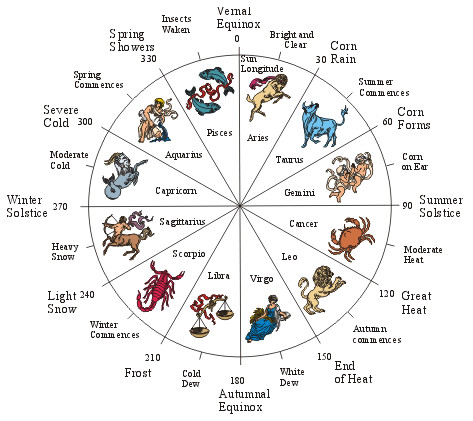Solar terms system reflects agricultural concept of time

This picture shows the relationships between the Twenty-Four Solar Terms with the twelve signs of the Western zodiac.
The Twenty-Four Solar Terms calendar system was added to the United Nations Educational, Scientific, and Cultural Organization (UNESCO) Representative List of the Intangible Cultural Heritage of Humanity in late 2016.
The Twenty-Four Solar Terms show an understanding of time and practices developed in ancient China through observation of the sun’s annual motion. The ancient Chinese divided the sun’s annual circular motion into 24 segments, calling each segment a specific “solar term.”
The criteria for its formulation were developed through observation of phenology, astronomy and other natural phenomena. The system has been particularly important for farmers, guiding their practices in the past several millennia.
Agriculture is closely related to nature’s rhythms. A solar year was divided into several segments on the basis of changes of astronomy, phenology, weather and other agricultural phenomena, said Liu Zongdi, a professor from the Advanced Institute of Confucian Studies at Shandong University. This allowed them to organize agricultural production and daily life, he said, adding that solar terms were subdivisions of agricultural seasons.
In early literature, such as the Book of Poetry and the Book of Rites, in the Western Zhou Dynasty (1046-771 BCE), the system of solar terms began to emerge. And it took shape and was recorded in Lü’s Commentaries of History during the Warring States Period (475-221 BCE), Liu said. The system of solar terms was further formalized and standardized in the Western Han Dynasty (202 BCE-AD 8) as recorded in Huainanzi, he said.
Liu Xiaofeng, a professor of history from Tsinghua University, said ancient China had a mature and developed agricultural civilization. The central activities of agricultural activities were to sow in spring and to harvest in autumn. The advanced development of astronomy and calendars in ancient China was directly related to the need to schedule agricultural activities, Liu said. This division showed ancient people’s views about the world and the universe, he said.
The Twenty-Four Solar Terms are able to provide fairly accurate predictions of the temperature, rainfall and other seasonal changes in nature, offering guidance for agricultural activities, said Wu Bing’an, an expert on folklore in China. Agriculture also determines the rhythm of public social life, so the system is also significant in folklore, creating all kinds of customs that affect people’s daily lives, he said.
China has used the Gregorian calendar for about a century. Although the most important function of the Twenty-Four Solar Terms has faded away in the industrial and information age, Wu suggests that the system still has guiding significance in agricultural production because agriculture is still fundamental to China’s economy.
As a traditional system and concept of time, the Twenty-Four Solar Terms calendar represents a sense of cultural identity in modern China, said Xiao Fang, a professor of folklore from Beijing Normal University.
Liu said the reinvention of the culture of the Twenty-Four Solar Terms is noteworthy. In order to satisfy people’s desires, new means for expression and communication should be used to rejuvenate the system by refining the traditional wisdom within it, he said.
ZHANG QINGLI is a reporter at the Chinese Social Sciences Today.

 PRINT
PRINT CLOSE
CLOSE